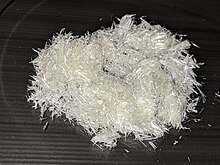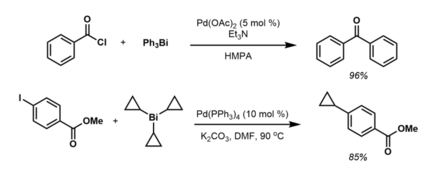|
Organobismuth chemistry Organobismuth chemistry is the chemistry of organometallic compounds containing a carbon to bismuth chemical bond. Applications are few.[1][2] The main bismuth oxidation states are Bi(III) and Bi(V) as in all higher group 15 elements. The energy of a bond to carbon in this group decreases in the order P > As > Sb > Bi.[3] The first reported use of bismuth in organic chemistry was in oxidation of alcohols by Frederick Challenger in 1934 (using Ph3Bi(OH)2).[4] Knowledge about methylated species of bismuth in environmental and biological media is limited.[5] DiscoveryTriethylbismuth, the first known organobismuth compound, was prepared in 1850 by Löwig and Schweizer from iodoethane and a potassium–bismuth alloy. As with most trialkylbismuth compounds, BiEt3 has an extremely pungent and unpleasant odor, and is spontaneously oxidized in air.[6] The chemistry of these complexes first began receiving significant attention when Grignard reagents and organolithium compounds became available. OrganoBi(III) compoundsProperties and structure Triorganobismuth(III) compounds are monomeric with pyramidal structures reminiscent of organophosphorus(III) chemistry. The halides however adopt hypervalent structures. This trend is illustrated by the sheet-like structure adopted by methylbismuth dichloride.[7] Most aliphatic organobismuth(III) compounds oxidize easily, with the lighter members pyrophoric. Dialkylhalobismuthines cannot be stored, as they decompose under even inert atmospheres.[8]: 413 Diarylbismuthines are among the most powerful sneezing agents known.[8]: 413 Organobismuth heterocycles are based on Bi(III). The cyclic compound bismole, a structural analog of pyrrole, has not been isolated, but substituted bismoles are known.[9] Bismabenzene has been detected in the laboratory.[10] SynthesisThe most general and widely-used methodology for homoleptic trialkyl- and triarylbismuth complex synthesis reacts BiX3 with organolithium or -magnesium reagents:[6]
Triorganobismuth compounds were first prepared instead from K3Bi and organic halides:[6]
This method is generally more difficult and produces a lower yield. However, it remained as of 2006 the only method for e.g., (Me3Si)3Bi synthesis.[6] Triaryl bismuth(III) compounds are typically air-stable crystalline solids, and the substituents will react before the carbon-bismuth bonds under appropriate conditions:[11]  Asymmetric organobismuth compounds proceed most naturally from the (unstable) organobismuth halides RBiX2 and R2BiX.[6] ReactionsIn industry, triarylbismuth compounds catalyze various alkene and alkyne polymerizations.[8]: 415 Triarylbismuth compounds have very limited use in organic synthesis.[12] Their bonds are weak, and easily displaced by other elements, metallic or nonmetallic.[8]: 413 Such reactions proceed more readily than for the lighter congeners. Of course, triphenylbismuth undergoes redistribution with its trihalide to give the mixed derivatives such as diphenylbismuth chloride (Ph2BiCl).[13] Bbismuth(III) reagents can transfer substituents to thallium(III) compounds:[8]: 414
Triarylbismuth(III) compounds may also be employed in C–N and C–C bond-forming transformations with an appropriate metal co-catalyst. For instance, Barton and coworkers demonstrated that amines could be N-arylated with a bismuth(III) reagent in the presence of copper(II) salt.[14]  Likewise acylchlorides react under Pd(0) catalysis to form a variety of phenyl ketones.[15] Although not formally arenes, tricyclopropylbismuth(III) reagents react with aryl halides and triflates under Pd(0) catalysis in a similar fashion to afford a variety of aryl and heteroaryl cyclopropanes:[16]  OrganoBi(V) compoundsStructure and stabilityThe thermal stability of R5M compounds decrease in the order As > Sb > Bi. The aryl compounds are more stable than alkyl compounds. Me5Bi decomposes explosively at 20°C.[citation needed] The nature of the aryl ligands is important in determining whether the complex's geometry is trigonal bipyramidal or square planar and its color.[6] In general, homoleptic compounds of the type Ar5Bi adopt square pyramidal structures. The pentaphenyl compound is deeply colored and thermochromic, possibly because of equilibration between geometries.[17] Carboxylates rarely form chelating complexes of bismuth. Instead, organobismuth carboxylates are typically polymeric, with each oxygen on the carboxylate coordinating to a different bismuth atom.[18]: 330–332, 344–345 The same is not true for xanthates.[18]: 334, 340 Bismuth halides coordinated to arenes are piano-stool complexes.[18]: 337, 341–343 Synthesis from bismuth(III) compoundsInterestingly, although very few inorganic BiV compounds are known, there is a wide variety of pentacoordinate organobismuth complexes.[8]: 415 Triarylorganobismuth complexes easily oxidize to bismuth(V) complexes when treated with chlorine or bromine, giving Ar3BiX2 (X = Cl, Br). Reactions with iodine instead displace ligands to give tricoordinate Ar3−xBiIx, whilst reactions with fluorine are too vigorous for control.[6] All-carbon organobismuth(V) complexes may then be accessed from displacement of the newly formed bismuth-halogen bond with an alkyl or aryl lithium or Grignard reagent. For example:
Unstable, purple Ph5Bi was the first to be synthesized so.[6] Bi(V) easily forms an onium ion for example by protonation with p-toluenesulfonic acid:[19]
Pentaphenylbismuth forms an ate complex upon treatment with phenyl lithium:[20]
In organic synthesisOrganobismuth(V) reagents are useful for a wide variety of organic transformations. Compared to their lighter congeners, Bi(V) compounds are strong oxidants, dehydrogenating alcohols of all kinds to the carbonyl and cleaving glycols to the aldehyde. They also engage in aryl transfers.[6] The compounds Ph3Bi(OOtBu)2, Ph3BiCO3 and (Ph3BiCl)2O have been investigated for oxime, thiol, phenol, and phosphine oxidation.[21][page needed] In general, oxidation accelerates when the aryl ligands have electron-withdrawing substituents, and attacks alcohols before thiols or selenides.[8]: 416–417 Hydrazines dehydrogenate to azo compounds and thiols to a mixture of sulfides and disulfides.[8]: 417–418 High yields require strongly basic conditions (absent it, the carbonate is the most effective), suggesting that the active species are triarylbismuth oxides. However, pentaarylbismuth compounds will also abstract hydrogen.[8]: 416–417 In general, bismuth(V) compounds arylate inefficiently, transferring only one of the five ligands to the substrate[22] and leaving behind a triarylbismuth(III) waste.[23] Reoxidizing the BiIII complex to BiV is hard, and impedes closing a catalytic cycle around this chemistry.[22] Nevertheless, Ph5Bi and Ph3BiCl2 do arylate 1,3-dicarbonyls and arenes:[24] In the reaction, the bismuth(V) reagent loses an aryl group and binds to oxygen. The subsequent arylation and elimination are asynchronous and concerted:[23]  Adjacent electron-pair donors determine regioselectivity. In the presence of a copper salt, such reagents arylate amines and alcohols. Under ultraviolet light as well, they monoarylate glycols. Steric hindrance governs their high selectivity: secondary alcohols are arylated over tertiary ones, and axial alcohols arylated over equatorial ones.[8]: 417–431 OrganoBi(I) compoundsBismuthinidene are analogous to carbenes since they have the general form R-Bi, with two lone pairs of electrons on the central bismuth(I) atom. Bismuthinidenes are unstable and very reactive due to the unusual +1 oxidation state but can be used in catalysts. See also
References
|
